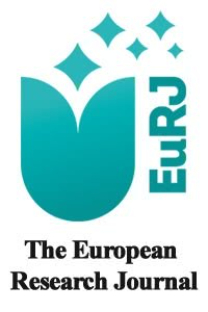Evaluation of hematopoietic- and neurologic-expressed sequence 1-like (HN1L) protein levels in tissue and plasma of breast cancer patients
Evaluation of hematopoietic- and neurologic-expressed sequence 1-like (HN1L) protein levels in tissue and plasma of breast cancer patients
HN1L, JPT2, breast cancer, cancer stem cell,
___
- 1. Ames BN, Gold LS, Willett WC. The causes and prevention of cancer. Proc Natl Acad Sci U S A 1995;92:5258-65.
- 2. Wilkinson L, Gathani T. Understanding breast cancer as a global health concern. Br J Radiol 2022;95:20211033.
- 3. Zhou G, Wang J, Zhang Y. Zhong C, Ni J, Wang L, et al. Cloning, expression and subcellular localization of HN1 and HN1L genes, as well as characterization of their orthologs, defining an evolutionarily conserved gene family. Gene 2004;331:115-23.
- 4. Liu Y, Choi DS, Sheng J, Ensor JE, Liang DH, Rodriguez-Aguayo C, et al. HN1L promotes triple-negative breast cancer stem cells through LEPR-STAT3 pathway. Stem Cell Rep 2018;10: 212-27.
- 5. Liu ZB, Ezzedine NE, Eterovic AK, Ensor JE, Huang HJ, Albanell J, et al. Detection of breast cancer stem cell gene mutations in circulating free DNA during the evolution of metastases. Breast Cancer Res Treat 2019;178:251-61.
- 6. Jiao D, Zhang J, Chen P, Guo X, Qiao J, Zhu J, et al. HN1L promotes migration and invasion of breast cancer by up-regulating the expression of HMGB1. J Cell Mol Med 2021;25:397-410.
- 7. Smith PE, Krohn RI, Hermanson GT, Mallia AK, Gartner FH, Provenzano M, et al. Measurement of protein using bicinchoninic acid. Anal Biochem 1985;150:76-85.
- 8. Kakarala M, Wicha MS. Implications of the cancer stem-cell hypothesis for breast cancer prevention and therapy. J Clin Oncol 2008;26:2813-20.
- 9. Bai X, Ni J, Beretov J, Graham P, Li Y. Cancer stem cell in breast cancer therapeutic resistance. Cancer Treat Rev 2018;69:152-63.
- 10. İlvan Ş. Meme Karsinomu Patolojisi. İÜ Cerrahpaşa Tıp Fakültesi Sürekli Tıp Eğitimi Etkinlikleri 2006;54:65-71.
- 11. Yousef AJA. Male breast cancer: epidemiology and risk factors. Semin Oncol 2017;44:267-72.
- 12. Markou A, Tzanikou E, Lianidou E. The potential of liquid biopsy in the management of cancer patients. Semin Cancer Biol 2022;84:69-79.
- 13. Thomas ML, Marcato P. Epigenetic modifications as biomarkers of tumor development, therapy response, and recurrence across the Cancer Care Continuum. Cancers (Basel) 2018;10:101.
- 14. Asante DB, Calapre L, Ziman M, Meniawy TM, Gray ES. Liquid biopsy in ovarian cancer using circulating tumor DNA and cells: ready for prime time? Cancer Lett 2020;468:59-71.
- 15. Cescon DW, Bratman SV, Chan SM, Siu LL. Circulating tumor DNA and liquid biopsy in oncology. Nat Cancer 2020;1:276-90.
- 16. Veyssière H, Bidet Y, Penault-Llorca F, Radosevic-Robin N, Durando X. Circulating proteins as predictive and prognostic biomarkers in breast cancer. Clin Proteomics 2022;19:25.
- 17. Aravanis AM, Lee M, Klausner RD. Next-generation sequencing of circulating tumor DNA for early cancer detection. Cell 2017;168:571-4.
- 18. Campos-Carrillo A, Weitzel JN, Sahoo P, Rockne R, Mokhnatkin JV, Murtaza M, et al. Circulating tumor DNA as an early cancer detection tool. Pharmacol Ther 2020;207:107458.
- 19. Mirzaei A, Madjd Z, Kadijani AA, Tavakoli-Yaraki M, Modarresi MH, Verdi J, et al. Evaluation of circulating cellular DCLK1 protein, as the most promising colorectal cancer stem cell marker, using immunoassay based methods. Cancer Biomark 2016;17:301-11.
- 20. Christman EM, Chandrakesan P, Weygant N, Maple JT, Tierney WM, Vega KJ, et al. Elevated doublecortin-like kinase 1 serum levels revert to baseline after therapy in early stage esophageal adenocarcinoma. Biomark Res 2019;7:5.
- 21. Nong S, Wang Z, Wei Z, Ma L, Guan Y, Ni J. HN1L promotes stem cell-like properties by regulating TGF-β signaling pathway through targeting FOXP2 in prostate cancer. Cell Biol Int 2022;46:83-95.
- 22. Li L, Zheng YL, Jiang C, Fang S, Zeng TT, Zhu YH, et al. HN1L-mediated transcriptional axis AP-2γ/METTL13/TCF3-ZEB1 drives tumor growth and metastasis in hepatocellular carcinoma. Cell Death Differ 2019;26:2268-83.
- 23. Wang ZY, Xiao W, Jiang YZ, Dong W, Zhang XW, Zhang L. HN1L promotes invasion and metastasis of the esophagogastric junction adenocarcinoma, Thorac Cancer 2021;12:650-8.
- 24. Ertürk E, Sarımahmut M, Gökgöz MŞ. [Evaluation of the effectiveness of HN1L as a novel biomarker candidate in aggressive breast tumors]. Proceedings of the 7th International Medicine and Health Sciences Researches Congress (UTSAK) 2021;216-7. [Oral Presentation in Turkish]
- 25. Sarımahmut M, Ertürk E, Gökgöz MŞ. Determination of the Potential of HN1L as a Biomarker in Luminal Type Breast Cancers. Proceedings of the VII. International Hippocrates Congress On Medical and Health Sciences 2021;16. [Oral Presentation in Turkish]
- ISSN: 2149-3189
- Yayın Aralığı: 6
- Başlangıç: 2015
- Yayıncı: Prusa Medikal Yayıncılık Limited Şirketi
Investigation of general surgery consultations in COVID-19 patients treated in a tertiary hospital
Mehmet Eşref ULUTAŞ, Kemal ARSLAN
Evaluation of organ donation process and affecting factors in COVID-19 pandemic
Expression and prognostic value of ING3 in advanced laryngeal squamous cell carcinoma
Neslişah BARLAK, Gülnur KUŞDEMİR, Rasim GUMUS, Abdulkadir ŞAHİN, Betül GÜNDOĞDU, Ömer Faruk KARATAS, Arzu TATAR
Gizem ÖZER, Pınar KAYGIN, Onur DİRİCAN, Serpil OĞUZTÜZÜN, Sezen YILMAZ SARIALTIN, Gülçin GÜLER ŞİMŞEK, Ayşegül ERDEM, Murat KILIÇ, Tülay ÇOBAN
Protective effects of methylprednisolone in kidney: aortic occlusion-reperfusion model in rats
Serkan SEÇİCİ, Kadir Kaan ÖZSİN, M.özgür ÖZYİĞİT, Omer ARDA, Yasemin ÜSTÜNDAĞ
Elif ERTURK, Mehmet SARİMAHMUT, Mustafa Şehsuvar GÖKGÖZ, Sahsine TOLUNAY
The mechanism of mindfulness meditation on pain by functional magnetic resonance imaging method
Yasemin YILDIZ, Sayad KOCAHAN, Alp Eren ÇELENLİOĞLU, Mehmet ÖZLER
Importance of paravertebral muscle quality in the etiology of degenerative lumbar spinal stenosis
Evaluation of the uric acid and hematological parameters in patients with nodal hand osteoarthritis
